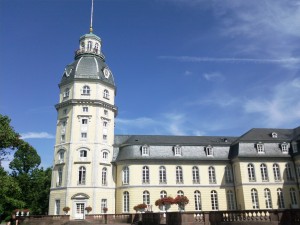For the first time in the history of AEGEE, the Agora is not organized by one, two, or even three locals. It’s organized by seven locals from the Rhein-Neckar region of Germany! Due to this high number of antennas and the variety of the area’s unique attractions you can be sure of experiencing one of the most diversified Agorae ever. In this article we will guide you through the region and give some attention to the highlights of each city and its surrounding countryside.
The Rhein-Neckar region is well-known for its picturesque areas around the valleys of the rivers Rhine and Neckar and it includes internationally renowned tourist destinations, as well as UNESCO World Heritage sites. In addition, thanks to its land climate, the Rhein-Neckar region is famous for wine growing and it is considered an indispensable German industrial area.
Here is a short overview over the hometowns of the organizing locals which will help you get a first glance at the region and plan your trip to the Agora:
Mannheim, the host town of the Spring Agora Rhein-Neckar 2013, is a multi-cultural city located at the confluence of the rivers Rhine and Neckar.
Due to the fact that the streets and avenues of Mannheim’s city center are designed in squares and arranged in a grid pattern (just like a chessboard), Mannheim is nicknamed „Quadratestadt“ („City of Squares“). Furthermore, the streets are distinguished by letters and numbers rather than by names.
One of Mannheim’s main attractions is the Mannheimer Schloss (Mannheim Palace), the largest Baroque construction in Germany which nowadays serves as the main building of the University of Mannheim and which will host part of the Agora Rhein-Neckar.
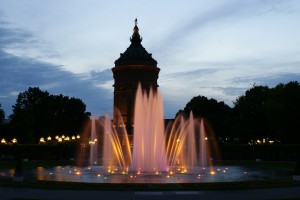 The landmark of Mannheim is the Wasserturm (Water Tower), an old tower located in the Friedrichsplatz, a beautiful art nouveau area of the city. This popular meeting point invites you to take a stroll, to relax and to admire the fountains at the foot of the tower.
The landmark of Mannheim is the Wasserturm (Water Tower), an old tower located in the Friedrichsplatz, a beautiful art nouveau area of the city. This popular meeting point invites you to take a stroll, to relax and to admire the fountains at the foot of the tower.
Another site to lay back and unwind after an exhausting Agora day is the 41 hectares large Luisenpark, one of Europe’s most beautiful parks, including a Chinese garden with a tea house, greenhouses with butterflies and birds exhibits, a model farm with domestic animals and a lake. Towering over the Luisenpark, you will find the over 200 meters high Fernmeldeturm (Telecommunication Tower), Mannheim’s tallest landmark with a viewing platform and a rotating restaurant which offer a breathtaking panorama of Mannheim and its surroundings. From here you can also see the SAP Arena, a multifunctional stadium, one of the largest and most high-tech in Germany, named after its sponsor SAP, a German software corporation.
If you prefer spending your time shopping, Mannheim is one of the most popular shopping cities in southwestern Germany. From the Paradeplatz you can reach Mannheim’s main shopping destinations located in the few streets with names within the squares: Breite Straße, Planken, Fressgass and Kunststraße. Furthermore, on the Marktplatz (Market Place) you can purchase fresh fruits, vegetables, and flowers every Tuesday, Thursday, and Saturday.
If you travel by train to the southeast of Mannheim it will take you about 20 minutes to reach the town of Heidelberg, a popular tourist destination and one of the most picturesque cities in Germany.
The hometown of Germany’s oldest university, the University of Heidelberg, founded in 1386, and the former center of the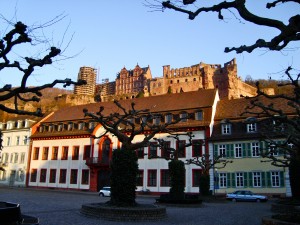 German epoch of Romantik (Romanticism) offers you a number of unique sights. You can stroll through the baroque style Altstadt (Old Town) and on the Hauptstraße (Main Street), a long pedestrian street running the length of the old city center, or you can visit Heidelberg‘s numerous historical churches such as the Heiliggeistkirche (the Church of the Holy Spirit), the Jesuitenkirche (the Church of the Jesuits) and the Peterskirche (St. Peter’s Church).
German epoch of Romantik (Romanticism) offers you a number of unique sights. You can stroll through the baroque style Altstadt (Old Town) and on the Hauptstraße (Main Street), a long pedestrian street running the length of the old city center, or you can visit Heidelberg‘s numerous historical churches such as the Heiliggeistkirche (the Church of the Holy Spirit), the Jesuitenkirche (the Church of the Jesuits) and the Peterskirche (St. Peter’s Church).
A sight not to be missed in Heidelberg are the ruins of the Heidelberger Schloss (Heidelberg Castle) located on the slopes of the Königstuhl hill.
By crossing the Neckar on the Alte Brücke (Old Bridge), a medieval bridge on the side of the old town, you can walk up the Heiligenberg (Saints’ Mountain). Here you can stroll along the Philosophenweg (Philosophers’ Walk) and enjoy the charming view over Heidelberg’s old town and castle before descending and taking a romantic walk along the banks of the river Neckar.
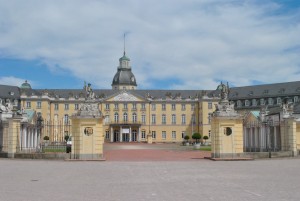 When heading south of Mannheim you will arrive in the city of Karlsruhe within 50 minutes. Here you can visit the Karlsruher Schloss (Palace of Karlsruhe), an interesting architectural composition including the city’s Botanical Garden. The city was designed with the palace and its tower as the center, from which 32 streets spread in the shape of a folding fan, thus giving Karlsruhe the nickname „Fächerstadt“ („Fan City“). One of the emblems of the city which should not be missed is the Marktplatz (Market Place) with a stone pyramid marking the grave of the city’s founder.
When heading south of Mannheim you will arrive in the city of Karlsruhe within 50 minutes. Here you can visit the Karlsruher Schloss (Palace of Karlsruhe), an interesting architectural composition including the city’s Botanical Garden. The city was designed with the palace and its tower as the center, from which 32 streets spread in the shape of a folding fan, thus giving Karlsruhe the nickname „Fächerstadt“ („Fan City“). One of the emblems of the city which should not be missed is the Marktplatz (Market Place) with a stone pyramid marking the grave of the city’s founder.
Karlsruhe is famous for many preserved examples of the art nouveau style of architecture, as well as for technology and engineering, with the Karlsruhe University being the oldest technical university in Germany.
If you head to the north of Mannheim, it will take you around 50 minutes to arrive in Darmstadt, an important German city of science which gave the chemical element darmstadtium its name.
With companies such as Merck, Röhm and Schenck, Darmstadt is a center of the pharmaceutical and chemical industry. Furthermore, the European Space Operations Centre (ESOC) of the European Space Agency, as well as EUMETSAT (the European Organisation for the Exploitation of Meteorological Satellites) are located in Darmstadt.
Moreover, the city is famous for numerous examples of the art nouveau period, such as the Rosenhöhe, an English-style rose garden from the 19th century, the Mathildenhöhe (with the Wedding Tower and the Russian Chapel) and many private villas. The colourful Waldspirale (Forest Spiral), a residential complex built by the Austrian artist Friedensreich Hundertwasser is also worth seeing.
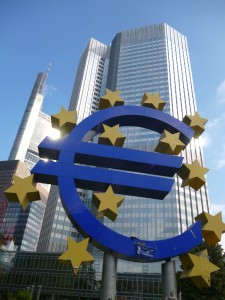 Travelling further up north, you will reach Frankfurt am Main, Germany’s fifth-largest city, an important financial, commercial and cultural center and the transport hub of the region.
Travelling further up north, you will reach Frankfurt am Main, Germany’s fifth-largest city, an important financial, commercial and cultural center and the transport hub of the region.
The European Central Bank, the German Federal Bank, the Frankfurt Stock Exchange, the Frankfurt Trade Fair, as well as numerous large commercial banks have their seats in Frankfurt.
Landmarks of the city include the Dom Sankt Bartholomäus (Saint Bartholomew’s Cathedral), the Paulskirche (Saint Paul’s Church) which was the seat of the first democratically elected Parliament in 1848, the Alte Oper (Old Opera), the Goethe-Haus, the birthplace of Johann Wolfgang von Goethe, and the Römer, a complex of several medieval houses that form the city hall of Frankfurt.
One of Frankfurt’s unique features is its high number of skyscrapers in the city center (especially in the Bankenviertel, the financial district), forming the Frankfurt skyline.
Frankfurt is also considered a shopping paradise with the Zeil being one of the most crowded pedestrian-only shopping 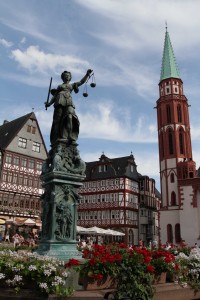 streets in Germany, and the Goethestraße, an expensive street full of prestigious shops.
streets in Germany, and the Goethestraße, an expensive street full of prestigious shops.
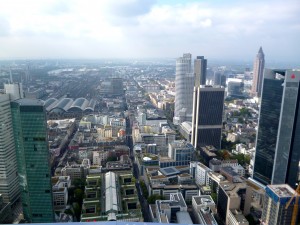 With more than 30 museums, Frankfurt contains one of the largest variety of museums in Europe.
With more than 30 museums, Frankfurt contains one of the largest variety of museums in Europe.
West of Frankfurt, around 80 minutes away from Mannheim, you will discover Mainz, the town where the movable type printing press was first invented by Johannes Gutenberg in the early 1450s. If you are interested in this topic, the Gutenberg Museum exhibits an original Gutenberg Bible, as well as many other printed books from the 15th century and later.
Furthermore, with Mainz having been founded over 2000 years ago, the city contains many Roman, Medieval, and even earlier artifacts which are exhibited in the Römisch-Germanisches Zentralmuseum (Romano-Germanic Central Museum) and the Museum für Antike Schifffahrt (Museum of Ancient Seafaring). Numerous other Roman remains (columns, ruins of a theatre and an aqueduct) are spread across the city.
Worth visiting in Mainz are the over 1000 years old Mainzer Dom (Cathedral of St. Martin) and the remaining towers of the city walls of Mainz – the Eisenturm (Iron Tower), a 13th-century gate tower, and the Holzturm (Wood Tower), a 15th-century tower.
Moreover, Mainz is one of the centers of the German wine economy, it is well-known for wine trade and it is the seat of the state’s wine minister (the federal state Rhineland-Palatinate is the only state to have such a department).
On the other side of the river Rhine you will encounter the city of Wiesbaden, which is famous for its thermal springs and spas, as well as for gambling and its casinos. If you pass through Wiesbaden it is worth visiting the neo-classical Kurhaus (Spa House) and the well-known Spielbank (Casino), as well as the Schloßplatz (Palace Square) which is situated in the city center and is surrounded by numerous magnificent buildings. The palace serves as the Landtag (parliamentary building) for the federal state of Hesse.
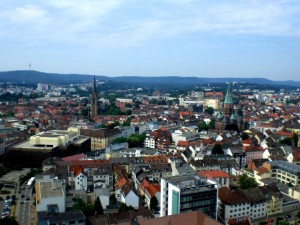 Located around 60 minutes away to the west of Mannheim, the last city we discuss is Kaiserslautern, a modern center of information and communications technology and the hometown of a well-known technical university, as well as numerous research institutes.
Located around 60 minutes away to the west of Mannheim, the last city we discuss is Kaiserslautern, a modern center of information and communications technology and the hometown of a well-known technical university, as well as numerous research institutes.
The Rathaus (Town Hall) of Kaiserslautern is one of the tallest buildings in the city center. From the bar located on the top floor you will have a panoramic view of the city and the surrounding countryside. In the Altstadt (Old Town) you will find the Kaiserbrunnen, an ornamental fountain with symbols such as a sewing machine, a car engine, a ship, a football and numerous others representing the city’s history.
An additional characteristic feature of Kaiserslautern is the Waschmühle (Washing Mill), a huge 160 metre long public swimming pool, the largest one in Europe.
If you would like to see a historical site, an old spinning factory, equipped with the latest sound and lighting technologies you would have to visit the Kammgarn (Combed Yarn), a top location for aspiring bands and performers and the cultural heart of Kaiserslautern.
As you can see, the Rhein-Neckar region is very diversified and it has an assorted mix of cities and sites for every taste and desire. So plan your trip, pack your bags and see you at the Agora Rhein-Neckar!
Written by Alexandra Stefanov, AEGEE-Heidelberg


